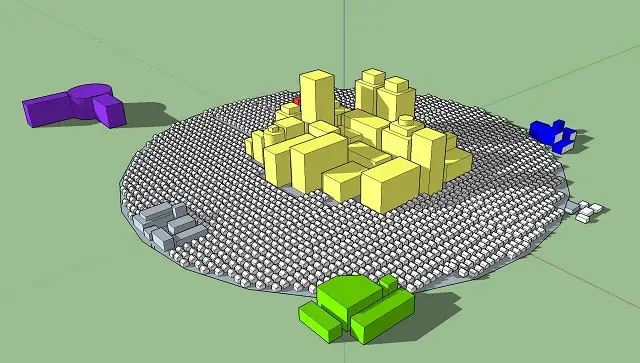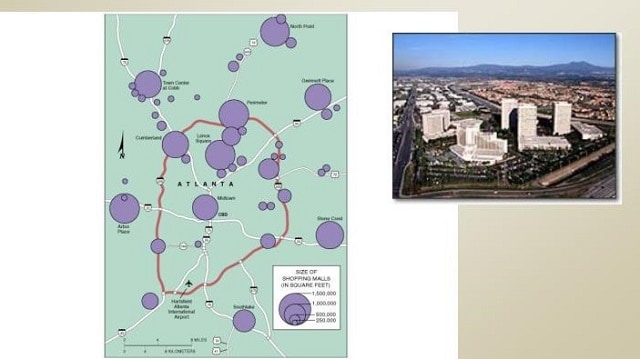The word galactic is derived from the word Galaxy in astronomy. Galaxy is a gravitationally bound system of stars, planets and other celestial bodies in the universe. Galaxy is a word derived from “Galaktikos” which means milky circle. These celestial bodies in the galaxy usually revolve around a center gravitational pull of a galaxy. So this is a circular system with an established center. Galactic city model is based on the concept of galaxies in space. It is also called as peripheral city model and is used for urban planning in many cities. It is a well known model in urban geography.
An overview of Galactic City Model
Galactic city model is a circular city model that has become popular with post-industrial cities. Galactic model has a commercial and economic central area which is often called the central business district or CBD is at the center of the city. The basic concept of this type of city model is high rise buildings in the city center. Low rise homes, residential areas and industrial, recreational and shopping districts surrounds the center of the city. This is a much planned urban model of cities. The city then expands in a circular fashion around the CBD. The following are some of the elements of the galactic city model:
Elements of Galactic City Model
CBD or City Center: The central business district or city center of the city is often the geographical heart of the city. This acts as the cultural, business, economic and political center of a city. In the CBD area, there are often skyscrapers and commercial buildings and town halls, government buildings and also buildings that represent the historic past of the city. The galactic city model has a high-density nucleus or city center and then the city expands in a circular fashion around the city center. The central urban area of the city is very high density in terms of population as compared to the urban sprawl surrounding it.

Related Articles:
- Multiple Nuclei Model of 1945 by C.D. Harris and Edward L. Ullman
- Hoyt Model or Sector Model (1939) of Urban Land Use by Homer Hoyt
- Burgess model or concentric zone model (1925) by Ernest Burgess
- Satellite City
- Rank-Size Rule
Suburban Residential Area: The city sprawls around the city center or CBD in a galactic city model. A portion of the city is the suburban residential area. This area is characterized as a residential district of the city with small and high homes, good schools and a suburban-style look to the district. This area lies inside the outer periphery of the galactic city model. It has hotels, parks, medical centers and all essential infrastructures for a residential area.
Circumferential Highway: The galactic city model is a circular city model with a center and a radius around the center which makes the city. The circumference of the city is often characterized by a circumferential circular highway that surrounds the entire city. This highway helps people avoid the traffic within the city and reach from one side of the city to another through the outer periphery of the city.
Radial Highways: Besides the circumferential highways, there are radial highways. These highways connect the periphery of the city from various points to the center CBD area of the city. These are often the main highways of the city which are also linked to the arterial roads within the city.
Shopping Center: Usually, in a galactic model, a shopping center or shopping district of a city is next to the residential area of the city and not in the city center. This makes it easier for residents living in the suburban residential zones of the city, to do their shopping in the nearby shopping district of the city. This is not a very strict rule as there are shopping centers all over the city.
Industrial District: Every major city in the world has industrial development. This means that there are industrial plants and factories in major cities all over the world. The industrial district in a galactic model of cities is located in one arc of this circular type of cities. Often these industrial districts are located on the other side of the residential areas. This is to keep the residential areas and industrial districts separate.
Edge Cities: Galactic model of cities often has many edge cities on the outskirts beyond the periphery of the main city. Edge city is a concept of a concentration of commercial and recreational infrastructure outside the city. These edge cities are often parts of the main city and are far away from the city center. They are often joined to the city center by highways or main roads. Edge cities have business centers, shopping centers and entertainment destinations for the residents of the main city.
Office Parks, Service Centers, Employment & Shopping Centers: Edge cities as described above are often beyond the peripheral edge of a city. Office parks are a concentration of offices outside the city limits. A good example of this is a software park. To encourage the software industry, a software park is a type of edge city where there is a concentration of software technology offices outside the city. Service centers, employment centers, and shopping centers are other types of high-density urban zones nearby outside the periphery of the galactic city model.
Airports: Generally, airports are outside city limits and far away from the city center in most cities in the world. An airport in the galactic city model is also outside the city. It is connected to the city with either the peripheral highways or the radial highways that are part of this type of city model.
Example of Galactic City Model
The best example of Galactic model is the city of Detroit in the United States of America. An aerial view of the city actually showcases how there is a central business district with high rise building and the urban sprawl that surrounds the central area of the city. Detroit is a city in the United States of America in the state of Michigan. This city is very well planned with radial roads, city center, historic architecture, modern residential districts. It was known for the expansion of the auto industry in the city.

Galactic city model is a much-planned city model in urban development. Cities that follow this type of model need to have a very structured planning system and space to expand the peripheries of the city. This is because the expansion of the urban sprawl takes place on all direction from the center of the city. The Galactic model adopts the concept of decentralization of cities. This means that all commercial and economic activity and all the power centers of the city do not only lie in the center of the city. There is a decentralization of power in such cities as power centers are spread out in various districts within the city.
Conclusion: These types of cities are very well planned to minimize commute times and keep residential areas separate from industrial areas. These cities have a set pattern of growth and as they are cities that are well planned, planning changes and adapting to new challenges is easy. This means that as well planned decentralized cities, cities that adopt the galactic model of urban development can adopt environmentally friendly change. They can expand in a structural way and can keep improving the city infrastructure as new technologies evolve. Without proper urban planning in cities, they will not be sustainable in the future. Galactic model cities are futuristic post-industrial cities with proper planning and development.
Related Articles: